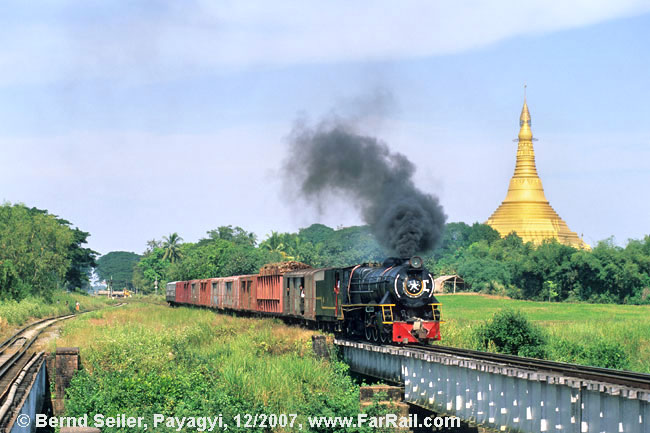

Almost ten years ago, as anticipated, Myanmar Railways stopped its remaining steam services. Since then I’ve tried to reactivate two steam locos for charter trains, but the prospects back in 2008 didn’t look good. They wanted to charge 25,000 US-Dollars for a single steam train which was well beyond any practical limit. We were unwilling to pay the money they wanted and they didn’t move their position. We continued to run steam charters on the fantastic mountain narrow gauge line in Namtu, but the metre gauge locos rusted away in Pyuntaza. We always mentioned that we would like to see one or two back in service for charter events when applying for photo permits or the permission to enter the restricted area around Namtu. Over the years it became clear that they would have listened to us if we would have shown up with suitcases of cash, as other businessmen probably did.
However, in the latter years of the military government, someone thought there might be a profitable business waiting and allowed the railway management to overhaul four metre gauge steam locomotives. However, they still didn’t want to run any charters for photographers. Their idea was to lease the locomotives to powerful travel agencies. Most of these large travel agencies, as well as most of the big businesses in the country, were and still are controlled by high ranking army officials or their family members. So they overhauled a YD, sent it to Bagan, and offered rides on a steam train for about 100 US-Dollars. It took them less than a year to find out that this plan did not work. At that price they couldn’t sell sufficient tickets to run the train.

The political change didn’t have any effect on the steam situation. The workshop at Insein continued to overhaul loco after loco, converting the overhauled YC to a coal burner even though
Eventually, after continued bothering, the officials in Naypyitaw finally gave us the principle answer we needed: a steam charter event is thinkable. However, the political change made it impossible to continue down this path until April 2016, when the new government took over control. Finally, they came out with not only possible, they also reconsidered their price and came down to a figure which seemed to be acceptable. It’s certainly not a cheapy, as hotels etc. are not cheap either, but it’s well worth the cost. Parts of the country haven’t changed much since the last steam loco was dumped, and despite the huge numbers of tourists flooding the country (and yes, the stupid Anti Burma Campaign is over), you’ll find such overwhelmingly friendly people all over the country that I’m sure we’ll be able to re-create the good old times.

We need to accept a few bearable compromises, as the locomotives have not been restored to fully working condition. They’ve reduced the boiler pressure, hence we can’t haul loaded trains with 25 wagons any more. But from the last years of steam, we all know that there were a lot of lovely, rural trains with only five to seven wagons. The vacuum braked, two axle wagons are disappearing at a fast rate, and stone trains are almost all air braked now. But we’ve found solutions to get authentic looking trains and time slots to run them on the single tracked lines. Although we have chartered trains on Myanmar Railways before, this will be a premiere. The people in charge these days don’t have any experience with charter trains and how they should be operated, so we’ll probably need to improvise a lot. As usual, we’ll do everything to make it a success but won’t promise anything. However, be assured, somehow it will work. Otherwise I wouldn’t have announced this event but cancelled it.
As often, we had to make some special arrangements in order to run an event in the style we want. I sent our guide to
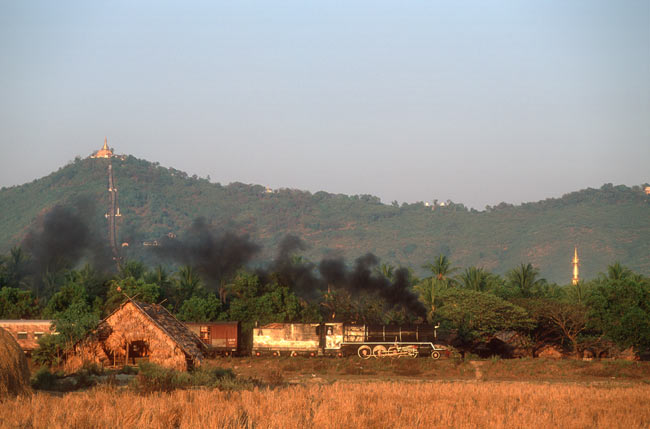
I’ve also added an extensive tourist programme after the railway part of the tour. “The Golden Land” it’s called, and after this tour you’ll know, why. We’ve included world heritage sites as well as lesser or completely unknown, but nevertheless very interesting spots.
We’ll meet lovely, welcoming people. We’ll feel the flair of a country which can hardly be described in words. It’s very easy to become a lover of
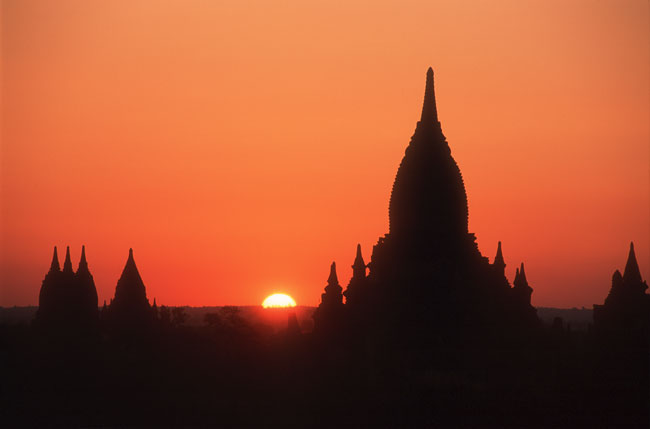
|
Date |
Itinerary |
|
07.01. |
Outbound flight to Myanmar |
|
08.01. |
Arrival in Yangon ( |
|
09.01. |
With a steam charter freight train we’ll go over the main line to Pyuntaza and return in the afternoon. We’ll start around 7 am and return around 6 pm. Be aware that trains can be delayed heftily in |
|
10.01. |
Do you remember the good, old Nyaungkhashe passenger? One of the last real mixed trains, serving a minor village at the foot of the destroyed bridge over the Sittaung. The line from Abya – Nyangkhashe won’t hold a locomotive anymore, but all the photo positions are before this. Charter mixed train Bago – Abya and back, Hotel in Bago |
|
11.01. |
The famous last steam line of |
|
12.01. |
We’ll continue our tour from Mokpalin to Thaton, starting shortly after sunrise and arriving around sunset. Accommodation in a guesthouse in Thaton |
|
13.01. |
We continue our tour in the afternoon from Thaton (dep. around 14 hrs to Zingyaik, arrival around 17:30 hrs). Our loco will continue light engine to Mottama depot. The loco can be turned there and will be prepared for the return train. We’ll give the loco crew a full day to make it fit for the return run. Today the group will be split. You can choose an option. Option A – Golden Rock: you’ll return to the guesthouse in Thaton, Option B Steam in the shed: you’ll continue to a hotel in Moulmine |
|
14.01. |
Option A: you’ll go up to the Golden Rock, a remarkable rock on top of a mountain which only remains in balance due to a hair of Buddah. Hotel in the mountains at the Golden Rock. Option B: we’ll go to the depot where our locomotive will be nursed, fuelled and turned on the turntable. Hotel in Moulmine |
|
15.01. |
In the morning we’ll return from the Golden Rock to the lowlands (Option A) or from Moulmine and meet the other party in Zingyaik, where stone trains will be loaded. Our charter train will be ready for departure in the early afternoon. We’ll follow our train from Zingyaik to Tathon. The best light for this section is after 14 hrs, so we’ll start in the afternoon and arrive around sunset. Guesthouse in Thaton or hotel in Moulmine. |
|
16.01. |
Early morning departure from Thaton. In the evening we’ll reach Bago again. Hotel in Bago |
|
17.01. |
In the morning we’ve arranged a transfer from Bago to the airport of Yangon. Return flight home. |
|
18.01. |
Arrival home. |
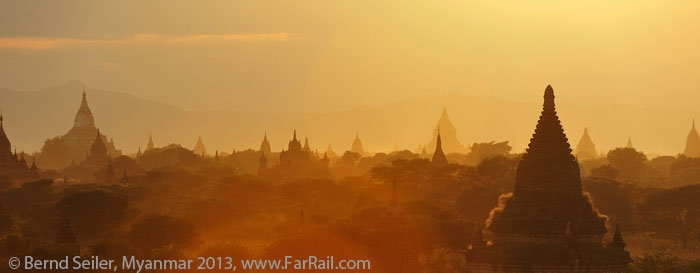
|
Date |
Itinerary |
|
15.01. |
Outbound flight to Myanmar |
|
16.01. |
Arrival in Yangon ( |
|
17.01. |
We stay in and around Bago where we’ll see the tallest pagoda of |
|
18.01. |
In the late morning we’ll go to |
|
19.01. |
Flight to Heho, where we’ll arrive in the afternoon. By charter bus we’ll continue to the famous |
|
20.01. |
In the morning we’ll go by boat on the The Hotel at Lake Inle. |
|
21.01. |
We’ll visit more highlights on and around the lake: the floating gardens, “giraffe neck women” from the Padaung tribe, visiting traditional villages, a silver smith, a black smith, a mechanical bamboo silk spinning and weaving mill. Later we’ll go by charter bus back to Heho airfield and fly to Bagan. Hotel in Bagan |
|
22.01. |
If you want you can experience a sunrise and a sunset in the pagoda fields of Bagan. There are hundreds of them, some truly splendid, some modest and humble. Their huge number and density creates an amazing ambience. Hotel in Bagan. |
|
23.01. |
The early bird ... and so on. Do like the birds do and take a seat in a balloon to fly at sunrise over the pagoda fields of Bagan. This spectacular view will be unforgettable. If you want to join us ballooning over Bagan you need to register as early as possible. It will cost you an extra of about £250/$370 but is worth every single Penny. That’s why it’s often sold out long ahead. After this event we’ll go to Mount Popa, an extinct volcano on the slopes of which can be found the sacred Popa Taungkalat monastery, perched dramatically atop a huge rocky outcrop. Hotel in Mt. Popa or Bagan. |
|
24.01. |
We’ll return to |
|
25.01. |
The Irrawaddy (new: Ayeyarwady, Ayeyarwaddy or Irawadi) is the most important water course of |
|
26.01. |
In the morning we’ll go by charter bus to Ava (Inwa) to visit the Maha Aungmye Bonzan monastery Bagaya monastery. If you want you can also climb the Sagaing hill on the other side of the river bank. Later we’ll have a look at the Manchester-like waving factories on the way to the U-Bein bridge. These machines date back to the 1930’s and are very noisy and impressive. A masterpiece of engineering, they remain in use until the Chinese cloth makers totally overrun the Burmese market. In the afternoon well visit the wooden U-Bein bridge. We’ll watch the sunset here. The bridge was built in 1784 from teak. Since then only the middle part has been replaced, the rest is still looking original. Once the first “fully-comprehensive-insurance-tourist” falls from the bridge it will almost certainly be spoiled by a huge railing and become less impressive. But for now the 1,200 metre long bridge is definitely a highlight. Hotel in |
|
27.01. |
Transfer to the airport of |
|
28.01. |
Arrival home |

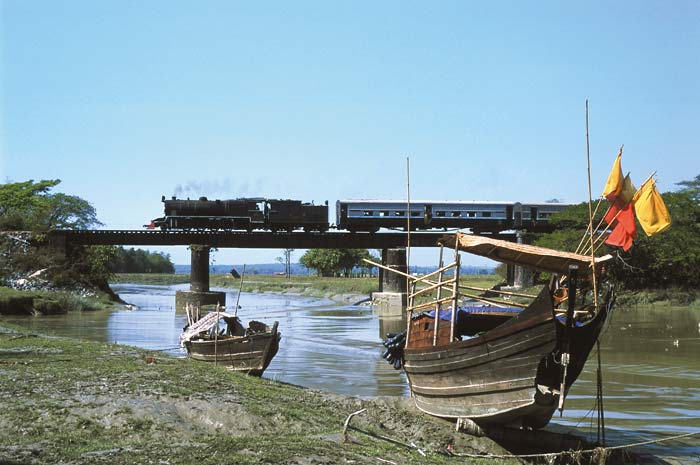
We asked for a stone train, but vacuum braked wagons are not available in the required number any more. However, there are still many other good looking freight wagons. Right until the very end of steam, Burmese steam locos used to haul general freight trains as well, not only stone trains. There were salt trains, mixed freight trains, sawn wood trains, oil tank trains etc, all hauled by steam. So it will be authentic, whatever we take behind the loco.
You might wonder why we’ll spend so much time with an afternoon train on just the section from Zingyaik to Thaton. The reason is that around Yinnyein there are some of the best positions of the whole line, so in this way we’ll make sure not to miss these positions in the best light, and so have chartered an afternoon train.
The second line
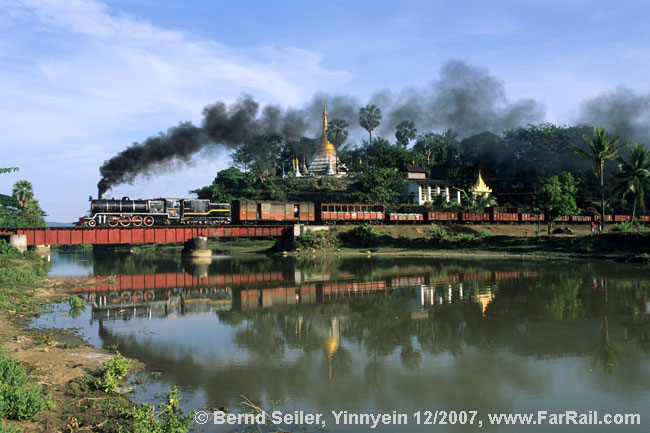

The rarely used locomotives now have a reduced boiler pressure, hence they can’t handle the same weight as before. In addition it is not certain that the locos will manage the whole route without mechanical trouble. Crews are no longer skilled and overhauls are very cheap, not carrying all the parts a workshop should do. The intention was to have them usable for light passenger trains only, with some three to maximum five carriages. So please expect delays not only from the operational perspective (they are very common in
Unfortunately, they re-converted the overhauled YC to a coal burner. This is absolutely useless for our purposes. We’re in talks with the railways to make it an oil burner again. It is possible, but, again, there are no guarantees. We hope to have both serviceable types of locomotives, the 2-8-2 class YD and the 4-6-2 class YC in use for our trains. And yes, talks to overhaul a YB are still undergoing. The railways didn’t plan to overhaul a YB, but we’re pushing them to change their mind.
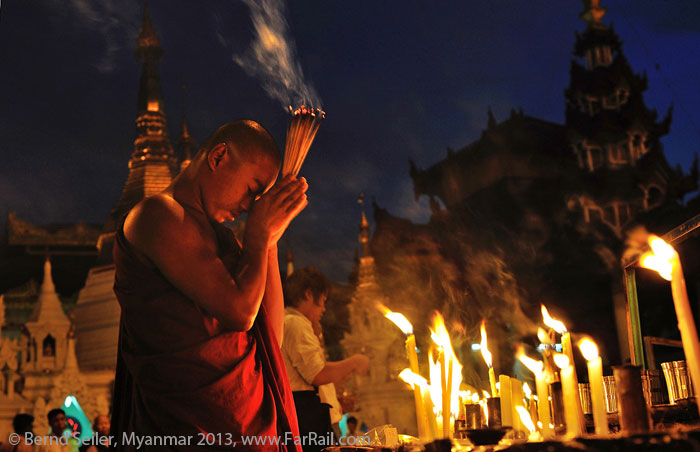
“As soon as the political situation changes the use of steam will be history (it will be history soon even under the current political situation), but you’ll never get another chance as well to see these ancient pagodas and other sights without being bothered by herds of other tourists.” – I wrote this in 2007 and exactly this has happened. However, it’s still worth it, and you can be assured it will become worse and worse as the tourist infrastructure is becoming better and better. Tourism increases year by year and will make the local vendors more aggressive. So far, it’s still bearable, although you can’t compare the situation with 2007 any more. So enjoy visiting over 1,000 or even 2,000 year old cultural sights to get an impression of the history of this great country. The Golden Rock is one of the centres of pilgrims. It is said that the rock at the very edge of the mountain top only balances because of a hair of Buddha which is inside the rock. The visit to the Golden Rock, which is included in the railway part of the programme, has a second reason: it’ll give us some quiet moments in our very ambitious programme of railway activities, in which we’ll always try to use the early morning and the late evening light to get the best possible shots. Also the railways will need this break to nurse the steam locomotive. It’s possible that we need to get up very early occasionally to get the best results in photography and videography. However, by 6pm it’s dark, so we can get to the hotel quite early. Keep in mind that we’re not going to

The scenic and cultural part of the tour is self-explanatory. More facts than you can remember about the sights we’re going to see you’ll find on the internet or in dedicated guide books. We’ll always find a solution for those who want to see the sunrise at a scenic spot and those who prefer to have a relaxed breakfast in the roof top restaurant of the hotel. Hotels are usually nice, clean and quiet and offer a decent standard. Only Bago seems to be a bit more basic as most of the tourists stay in


If you’ve not been to
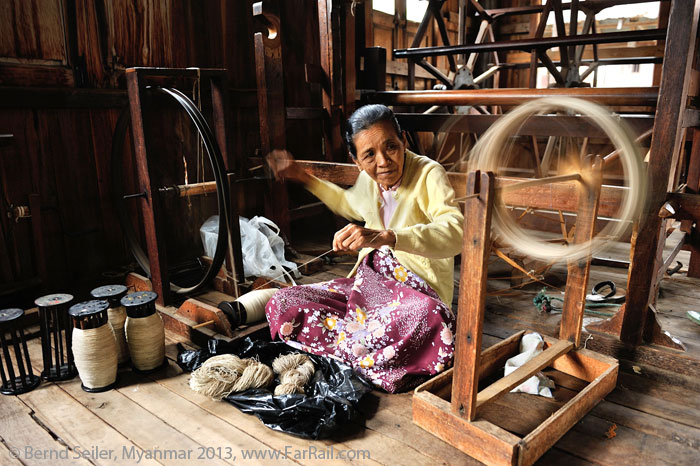
A chartered tour bus will follow the steam trains. Occasionally we’ll board the train to get to some photo spots, but in the negotiations it turned out that Myanmar Railways sees a problem with this – although it was never a problem in the years before 2007. To get the permission to run the tour we had to agree to following the train by charter bus. The trains will stop at stations for some time, so we have the chance to overtake the train.
Some difficulties have to be mentioned. Timekeeping is not as important as in Europe or North America. Given this, the scheduled times are a declaration of intent by Myanmar Railways and delays of several hours are not unusual.
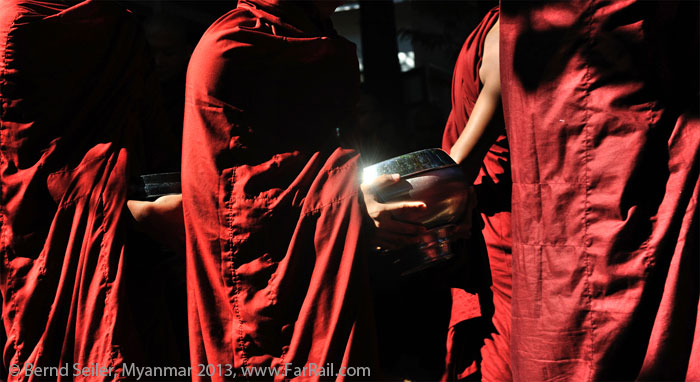
By January 2017 there should be at least three serviceable steam locomotives available, two YD and at least one YC. Unfortunately the currently serviceable class YC is coal fired and hence not usable for our purposes. We’re talking about the problem, but we can’t guarantee anything.
All in all the technical condition of the railway and its equipment is not suitable for guaranteeing anything. Steam locos of Myanmar Railways haven’t been used for a long while and haven’t been fully overhauled. They’ve just made them serviceable again. It might be possible that some parts of the programme cannot be operated as planned and need to be skipped without replacement or compensation. Paid money will not be refunded by any of the Burmese officials or railways, even if they couldn’t offer what we have paid for. However, we don’t expect serious difficulties in this matter, on all the recent tours the contractors in
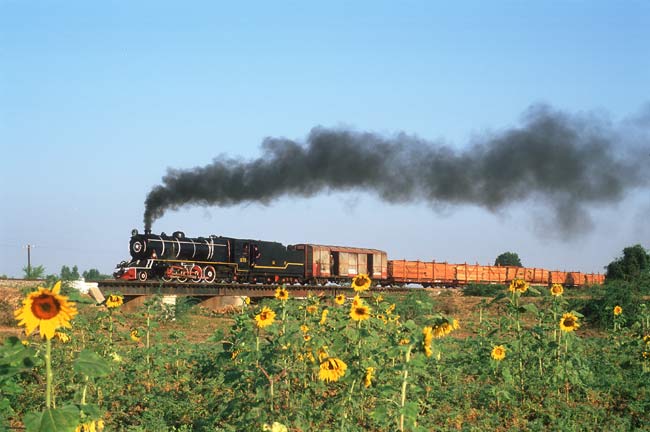
We may change the itinerary slightly to make the most out of it. Changes might be necessary with short notice in advance.
Charter buses (mostly with air conditioning), local airplanes and trains as well as accommodations represent the standard of our host country, which may seriously deviate from European, Australian or North American expectations. While we will try to avoid long walks, some photo positions may require a bit of an extra effort. The first part of the itinerary is designed especially for photographers and video filmmakers. To make the most out of it we may change our route or hotels/guesthouses without any notice in advance. This does not apply for the Golden Land tour where we’ll focus not only on photo spots, but also on a certain level of comfort and relaxation.
On the Steam & Pagoda part of the tour the standard of hotels in smaller places is below a Polish youth hostel. Please be prepared. After you have seen and felt the quality of the roads you’ll understand why we don’t go long distances just to get to a better hotel.
Please note that morning trains on the Steam & Pagoda tour have a higher priority than a breakfast in the hotel. So breakfast will be served as a packed box if necessary. Lunch and dinner are planned according to the situation of the steam train timetable. If necessary we’ll buy some papayas, bananas and oranges instead of risking missing some good pictures with a time consuming restaurant stop. Excellent lunches, with local fruit and rice and curries are usually available in the small stations along the railway too. Beverages are not included in the tour price.
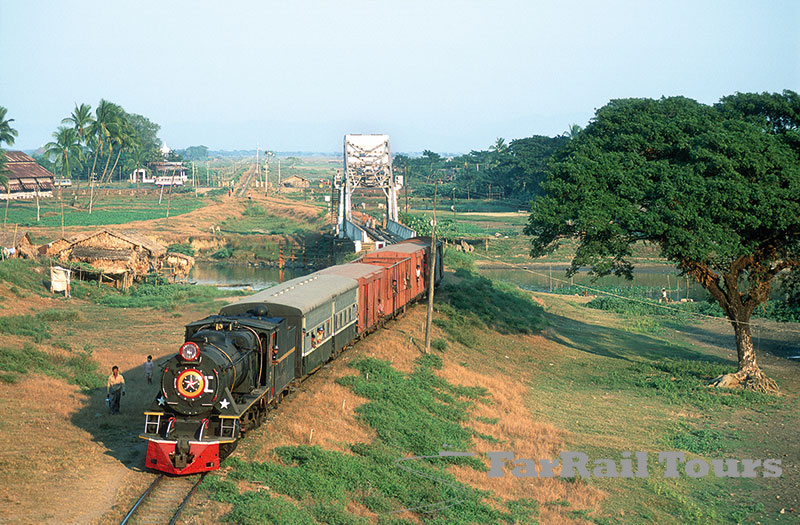
Please bear in mind that accommodation and transportation in
We recommend that you take some US dollars with you. To change some money at the airport for souvenirs or beverages, other currencies like British Pounds are ok as well. With about $250 US you should easily be able to cover all expenses.
Charging rechargeable batteries in the hotels is not a problem. Sometimes there’s a power cut, and the hotel’s generator set is not able to deliver the same voltage as the country’s network. Therefore recharging batteries can take a longer time than usual. However, no one missed a picture on the recent trips because of a battery problem.
Despite some difficulties we might face, you’ll be positively surprised by this lovely country and its friendly and welcoming people.

| Burma (Myanmar) | ||
| Steam & Pagodas | 21 to 37 participants | £2,740 |
| 07.01.2017 – 18.01.2017 | Single room surcharge | £270 |
| Registration Deadline: 04.10.2016 | ||
| The Golden Land | 12 to 35 participants | £1,760 |
| 15.01.2017 – 28.01.2017 | Single room surcharge | £410 |
| Registration Deadline: 04.10.2016 | ||
The discount for booking parts of the tour together is £120.
The price includes:
Not included are:
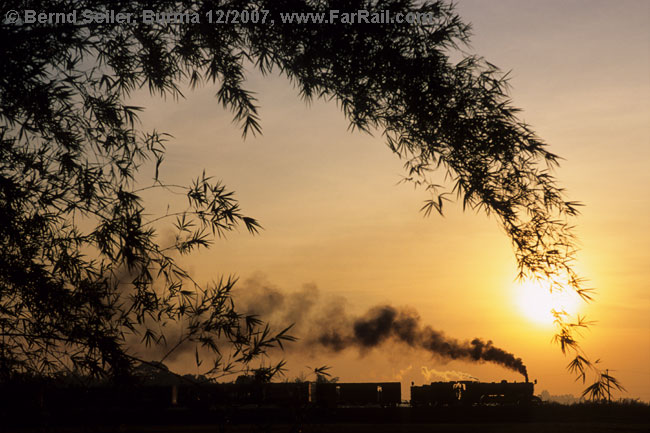
© FarRail Tours - e-mail: Bernd Seiler - zurück zu FarRail Tours
Click here to return to FarRail Tours